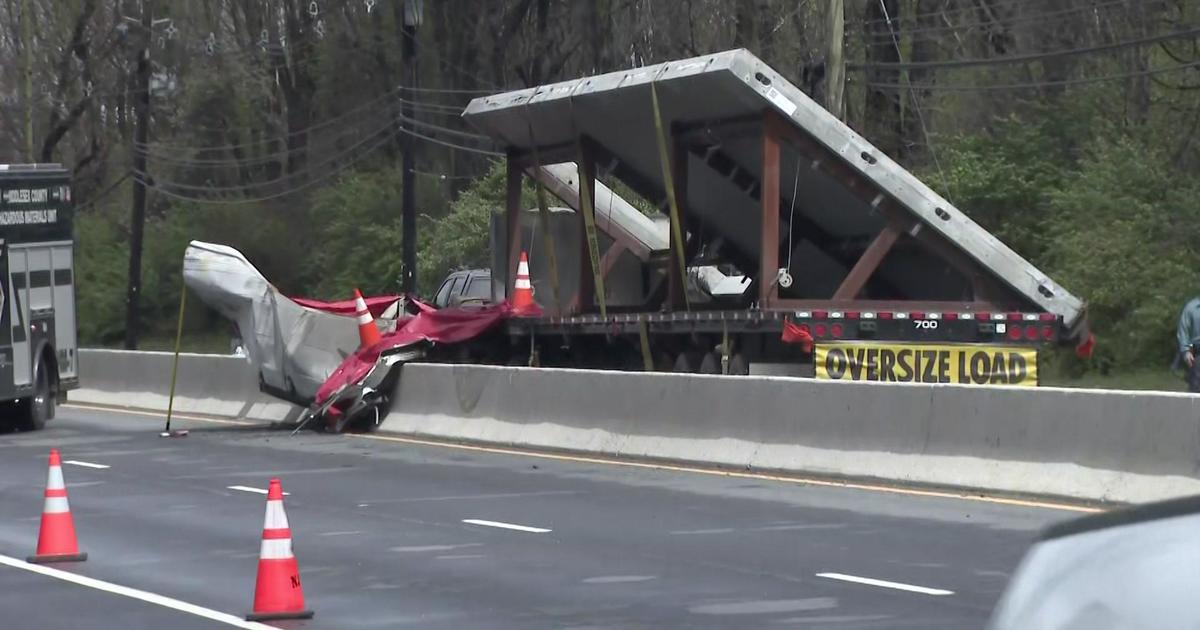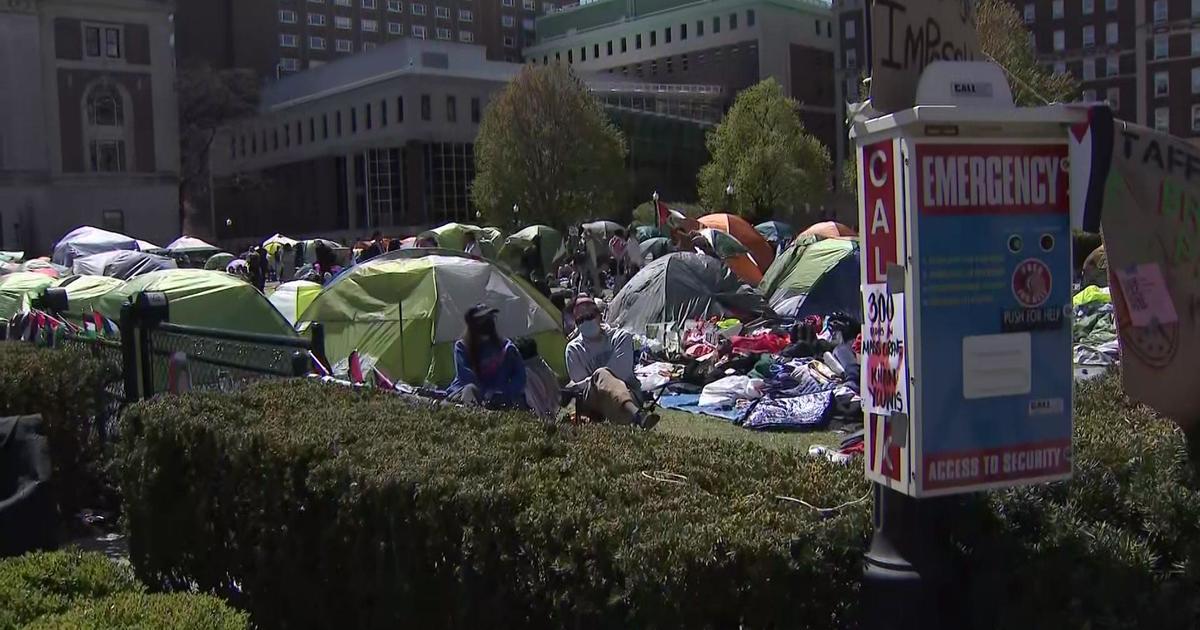Officials: Engineer Left Voicemail About Cracks 2 Days Before Florida Bridge Collapse
MIAMI (CBSNewYork/AP) — An engineer left a voicemail two days before the deadly pedestrian bridge collapse in Florida, saying cracks had been found in the concrete span, Florida Department of Transportation officials said Friday night.
The agency said the voicemail was left on a landline and was not heard by a state DOT employee until Friday, because the employee had been out of the office on assignment.
Click here to hear the voicemail
In a transcript released Friday night, Denney Pate with FIGG Bridge Group says the cracking would need repairs "but from a safety perspective we don't see that there's any issue there so we're not concerned about it from that perspective."
"Hey Tom, this is Denney Pate with FIGG bridge engineers. Calling to, uh, share with you some information about the FIU pedestrian bridge and some cracking that's been observed on the north end of the span, the pylon end of that span we moved this weekend. Um, so, uh, we've taken a look at it and, uh, obviously some repairs or whatever will have to be done but from a safety perspective we don't see that there's any issue there so we're not concerned about it from that perspective although obviously the cracking is not good and something's going to have to be, ya know, done to repair that. At any rate, I wanted to chat with you about that because I suspect at some point that's gonna get to your desk. So, uh, at any rate, call me back when you can. Thank you. Bye."
ALSO SEE: Complete Coverage From CBS Miami
At a news conference Friday night, officials from the National Transportation Safety Board said they had just begun their investigation, and could not yet say whether that cracking contributed to the collapse. They also said workers were trying to strengthen a diagonal member on the pedestrian bridge at Florida International University when it collapsed.
Reporters from CBS Miami asked the NTSB about the cracking.
NTSB investigator Robert Sumwalt: "I don't think we know at this point factually that there was a crack in the bridge…"
Reporter: "But it's been confirmed."
Sumwalt: "Well, we have not confirmed that."
When asked about the protocols in place for cracking in a structure, the response was still unclear.
"I would have to say that a crack in a bridge does not necessarily mean that it's unsafe. I know the crews were out there inspecting it and they were applying tension to strengthen a member," NTSB investigator Robert Sumwalt said. "I don't know if that was related to the cracks that they discovered that's still too early in the investigation for us to determine."
In a news release late Friday, FIGG Bridge Engineers said it "continues to work diligently" to determine the cause of the collapse, and is examining the steps its team has taken. It added, "The evaluation was based on the best available information at that time and indicated that there were no safety issues." It also asked for time to accurately determine what led to the accident.
Miami-Dade Police Director Juan Perez told reporters Friday he expects additional victims to be found as the massive concrete structure is removed.
Perez said the main priority was getting to the victims in crushed vehicles under the rubble as quickly as possible.
"This is a tragedy that we do not want to re-occur anywhere in the United States," Perez said.
Earlier Friday morning, police confirmed that at least six people were killed in the collapse. Sweetwater Mayor Orlando Lopez said at least one of the people who died was a Florida International University student.
"We are truly saddened to hear that," Lopez said. The identities of the victims have not yet been released. At least nine other people were injured.
Authorities said the stability of the bridge was a major concern as crews continue their work.
"We exhausted last night all of our search and rescue capabilities in hopes of finding additional survivors. We used auditory, we used visuals, we used our canines and we've determined that there is no longer any survivors," said Miami-Dade Fire Chief Dave Downey. "We'll continue to work in order to get all of these victims removed and we ask again that everybody keeps the families in your thoughts and prayers and understand that this is going to be a long-term operation."
Perez also said Friday a criminal investigation has been launched.
"Right now, we want to find out what caused this collapse, what caused this to occur," he said.
That doesn't mean charges will be filed, but he said that's a possibility. The Miami-Dade attorney's office is also involved.
The NTSB sent a 15-person team, which may not have full access until all the victims are removed.
"Our priority is to be here to find out what happened and to prevent this from happening again," said Chairman Robert Sumwalt.
The chairman was asked if the bridge was allowed to go up without certain precautions being taken.
"That is part of our investigation, and that investigation will be thorough and comprehensive and will take a while, but when it's done, we will have those answers," he replied.
The moment of the collapse Thursday was captured on surveillance video as plumes of dust could be seen rising from the rubble.
"The only thing you could see were the car lights in the front," one witness said. "Totally smashed to the ground."
The pedestrian bridge made up of 950 tons of concrete and steel toppled onto eight cars on the busy highway below, crushing them.
Time-lapse video shows the $14 million project from its start to its unveiling. The walkway, which spanned about 200-feet, was to connect FIU to the City of Sweetwater.
The bridge, which had not yet opened, had just been installed Saturday with a big celebration.
"What was soon to become an iconic staple part of the connectivity between the city and the university has turned out to be a national tragedy," Lopez said Thursday.
"This bridge was about goodness, not sadness," FIU President Mark Rosenberg said Thursday. "Now we're feeling immense sadness, uncontrollable sadness."
The bridge was pre-fabricated, being built using what's called the "Accelerated Bridge Construction" method, which is supposed to make it safer for workers, pedestrians and commuters.
When asked Friday who made the decision to not shut down traffic while work was being done on the bridge Thursday, Perez said "we don't know that."
"We're going to have to get to the bottom of that," he said.
Sen. Marco Rubio, meanwhile, tweeted that cables that suspend the bridge had loosened, and "were being tightened when it collapsed."
As CBS2's Dave Carlin reported, the method has been successfully used on bridge in New York City and New Jersey.
"Prefabrication is widely used," said Barry LePatner, a construction lawyer who authored the book "Too Big To Fall" on America's bridges and infrastructure.
He told Carlin that ABC technology is regulated and works.
"It has many, many attributes that support it as a very good method to speed up design and construction," he said.
LePatner said older, neglected bridges pose a bigger problem nationwide. He said additional money from Congress is desperately needed, but even a tragedy like this is unlikely to change things.
"I don't have a current hope that we have the national will or the political leadership at all levels of government to start to recognize how critically important it is to address these perilous infrastructure problems," he said.
The project was a collaboration between MCM Construction, a Miami-based contractor, and Figg Bridge Design, based in Tallahassee. FIGG is responsible for the iconic Sunshine Skyway Bridge across Tampa Bay.
FIGG issued an earlier statement Thursday saying the company was "stunned" by the collapse and promising to cooperate with investigations.
"In our 40-year history, nothing like this has ever happened before," the company's statement said. "Our entire team mourns the loss of life and injuries associated with this devastating tragedy, and our prayers go out to all involved."
MCM Construction Management, which was building the bridge, posted a message on the company's Facebook page promising "a full investigation to determine exactly what went wrong."
But CBS News reports that the two firms behind the construction have been accused of unsafe practices in the past.
Earlier this month, MCM was sued by a TSA employee who was hurt at the Fort Lauderdale Airport, where the company is working on an expansion.
The suit said the worker was injured when a makeshift MCM-built bridge collapsed under his weight.
FIGG was fined in 2012 after a 90-ton portion of a bridge the company was building in Virginia fell onto railroad tracks below, causing minor injuries to several workers.
The Virginian Pilot reports that state regulators fined FIGG $28,000 for safety violations saying it was "pure luck no one was killed."
A review of Occupational Safety Health Administration records shows that MCM has been fined for 11 safety violations in the past five years. The fines totaling more than $50,000 arose from complaints about unsafe trenches, cement dust and other problems at its Florida work sites.
The university had been touting the bridge, saying it was being built to last 100 years. It was scheduled to open next year.
(© Copyright 2018 CBS Broadcasting Inc. All Rights Reserved. The Associated Press contributed to this report.)



